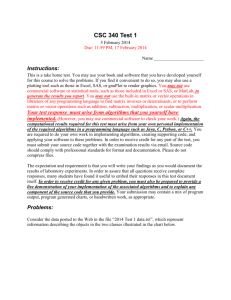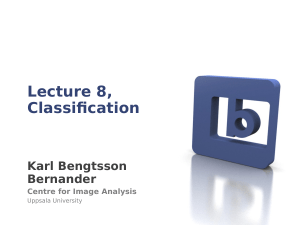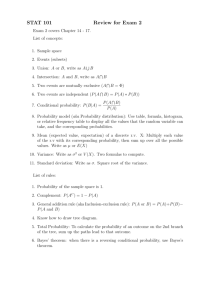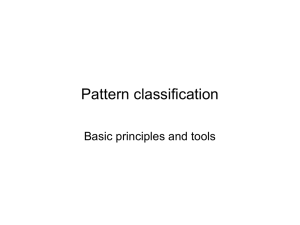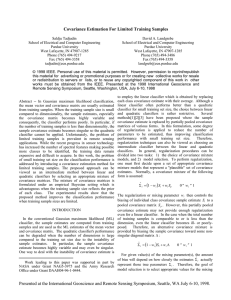Homework 4
advertisement
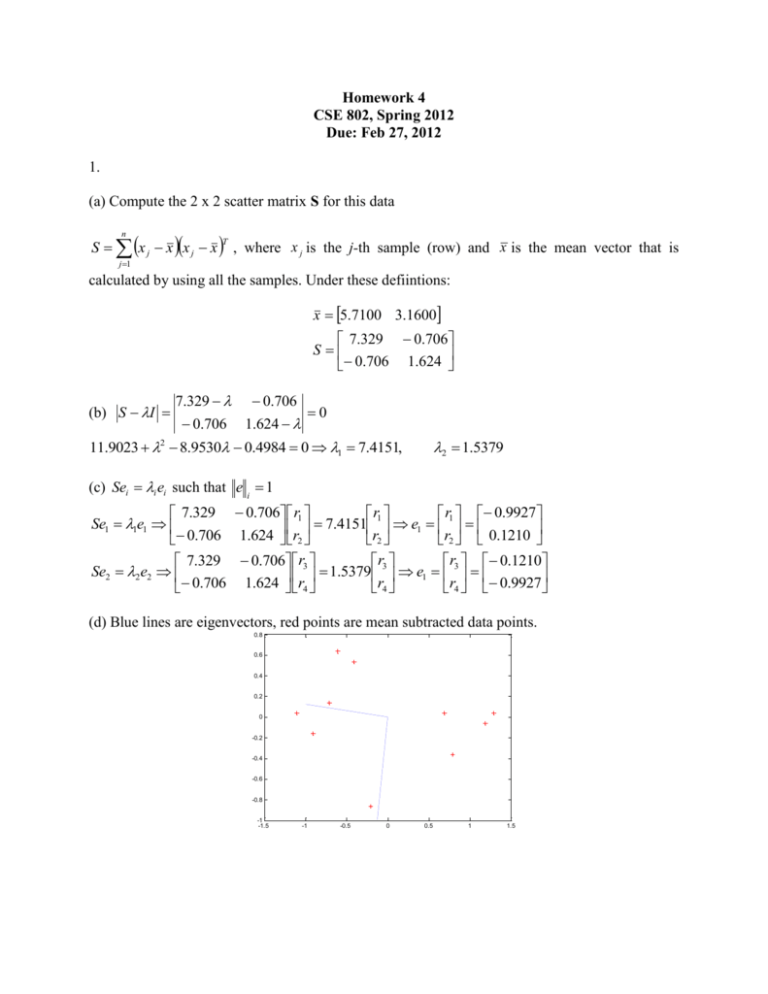
Homework 4 CSE 802, Spring 2012 Due: Feb 27, 2012 1. (a) Compute the 2 x 2 scatter matrix S for this data T S x j x x j x , where x j is the j-th sample (row) and x is the mean vector that is n j 1 calculated by using all the samples. Under these defiintions: x 5.7100 3.1600 7.329 0.706 S 0.706 1.624 (b) S I 7.329 0.706 0.706 1.624 0 11.9023 2 8.9530 0.4984 0 1 7.4151, 2 1.5379 (c) Sei i ei such that e i 1 r r 0.9927 7.329 0.706 r1 Se1 1e1 7.4151 1 e1 1 0.706 1.624 r2 r2 r2 0.1210 r r 0.1210 7.329 0.706 r3 Se2 2e2 1.5379 3 e1 3 0.706 1.624 r4 r4 r4 0.9927 (d) Blue lines are eigenvectors, red points are mean subtracted data points. 0.8 0.6 0.4 0.2 0 -0.2 -0.4 -0.6 -0.8 -1 -1.5 -1 -0.5 0 0.5 1 1.5 2. (a) Since each pattern class has a multivariate Gaussian density with unknown mean vector and a common but unknown covariance matrix, we will estimate the mean for each class as the mean of the training patterns for that class. The way to compute the common covariance matrix is to first compute the covariance matrix of the three different classes and then average them as the common covariance matrix. The performance of the plug-in classifier for this data gives the average error rate for 15 rounds cross validation: 0.0248 and variance of error rate: 0.00051995. The result of individual run is listed in Table 1. (b) Since each of the classes has different class mean and covariance matrix, we separate data of different classes and compute the parameters for each of the pattern class. Also, because their covariance matrices are different, the resulting decision boundary is quadratic. The average error rate for these 15 rounds cross validation is: 0.0353. The variance of error rate is: 0.00061515. The result of individual run is listed in Table 1. (c) For parzon window classifier: Window size = 0.01, Average error rate = 0.6549. Variance of error rate = 0.0001. Window size = 0.5, Average error rate is 0.0549. Variance of error rate is 0.0006. Window size = 10.0, Average error rate is 0.4902. Variance of error rate is 0.0010. (d) Comparing the results in (a) and (b), we find that the quadratic classifier performs in a little bit worse than the linear classifier for the IRIS data. So the complicated decision boundary does not necessarily leads to good performance. One of the reasons might be that the linear classifier uses more data to compute the covariance matrix and so the resulting variance of the prediction error is smaller. Comparing the result of the Paren classifier on different window sizes, we can see that the error rate is greatly influenced by the window width. A width of 0.5 is beter compared with 0.01 and 10. Comparing the result of (c) with (a) and (b), we see that the result using 0.5 as the window size actually achieves comparable performance with the method in (a) and (b). The error rates are all in the range of 2%-4%. The following table lists running time for the three methods, which includes, load data time, and computation time for 10 rounds of cross validation: We see from the above table that the running time gets longer and longer as the computation of the classifer increeas. While the selection of the appropriate window size takes some effort, the advantage of Parzen window classifier over other methods is that the non-parmetric method does not need to assume the underlying distribution is Gaussian distribution. 3. (a) 2D plot of IRIS data using PCA is shown in Figure 1. The corresponding plot using MDA is shown in Figure 2. MDA provides better separation than PCA, since MDA utilizes the class category information to project the data. (b) Percentage variance is the variance retained by the eigenvalues in PCA projection. The value for the 2D projection for IRIS data is 0.9776. (c) We assume the following three categories of the IRIS data: 1: setosa. 2: versicolor. 3: virginica. The discriminant function for class 1 is: g1 = -22.* x12 + 24.* x1 * x2 -15.* x22 +14.* x1+ 22.* x2 - 27 The discriminant function for class 2 is: g2 = -8.2.* x12 + 4.8* x1 * x2 -9.8.* x22 +8.4.* x1+ 27.* x2 - 24 The discriminant function for class 3 is: G3 = -7.1.* x12 + 2.8* x1 * x2 -5.2* x22 +23.* x1+ 15.* x2 - 35 The error rate for the classifiers is 0.0267. Note that when you compute the error rate, you need to compute the value of the three discriminant functions simultaneously. Compared with problem 1 b), this error rate is smaller. This is because the 2D projection using MDA projects the data into a linear sub-space, which separates the true categories as well as possible.




